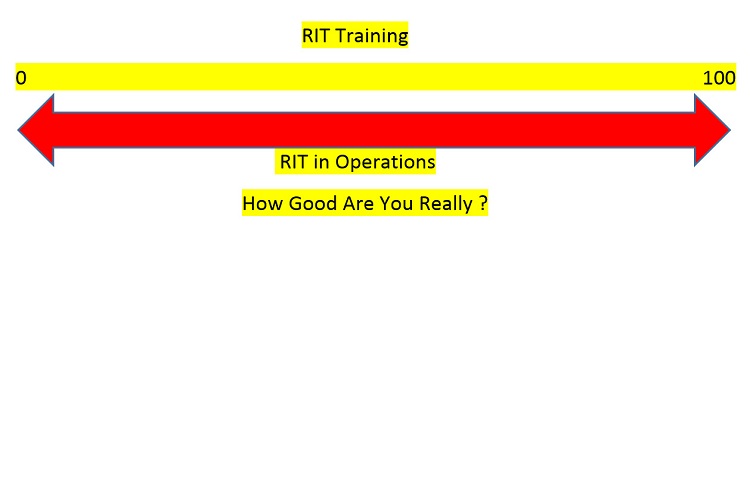
By David L. Haines
The question of the title was posed to me amid the frustration felt by an assistant chief after seeing numerous bills, requests, and items pertaining to our rapid intervention team (RIT) had crossed his desk repeatedly in a relatively short time span. He came into the office as I was working on an RIT training presentation and asked what I was working on. After I told him, he responded with “How RIT can you get? I’m tired of seeing RIT!”
His frustration with this subject mirrored my own, although from a completely different perspective. His frustration was from constantly seeing paperwork and money being spent on an ongoing RIT equipment project. Mine came from the perspective of a company officer and instructor trying to incorporate RIT into training and cultivate a better mindset about it within the department.
So, “How RIT can you get?” To answer that question, you must start with an understanding of RIT concepts and assess what you are currently doing. The answer involves your department’s capabilities, your training, your standard operating procedures (SOPs), and your current practice. How well do you meet the need for RIT in training and, more importantly, on the scene?
The basic concepts of RIT should be ingrained in every firefighter at the earliest possible opportunity in their training along with the basics of firefighter safety and survival; the frustration I feel as an instructor is in the limits that exist with the ability to do this. Time constraints in a Firefighter I or II program demand sticking to the basics, leaving little time for anything extra. As an instructor, knowing the importance of this training, I sneak it in at every opportunity. It’s still never enough, though, especially if that is the majority of their fire training for an extended period of time in their career. Depending on the culture of the department and the constraints presented by work and family commitments, that may be the case.
Ideally, every firefighter on the fireground should have a good working knowledge of the basics of RIT and firefighter survival and rescue techniques. Along with this, they should also have a deep personal appreciation for the importance and need for RIT to exist on the fireground. We should never hear a firefighter say, “Oh no, I’m stuck on RIT again.” This appreciation for the role of RIT should be a fundamental part of their training and show in their actions on the fireground. Personnel assigned to RIT need to be trained sufficiently for the role and be aware of the importance, ready to accept the awesome responsibility that comes with being the potential safety net for their brother or sister firefighters if they are in trouble.
“How RIT can you Get?” How RIT do YOU want things to be if YOU are the Mayday firefighter? We all need to look at RIT and Mayday as a two-sided coin. On the one side is the Mayday—firefighters must know to call it early and give good information when they do so. This should not only accompany basic self rescue techniques, but probably come before these are attempted. They must know the risks and understand there is a real possibility of them having to call one on today’s fireground. It has to be personal to them or there is no buy-in. They must equate RIT with being their own safety net if they were to call the Mayday.
RELATED: Terriaco on Basic RIT Tools on the Apparatus ‖ McCormack on RIT Operations ‖ McClelland on Fundamentals of RIT
When I ask about RIT in classes and drills, the answers are often given as third-party references, as if they think RIT is for those other firefighters, “Not me! It wont happen to me, right?” Every firefighter should be able to look down at their chest and see that there is no giant “S” emblazoned there. We can’t think of ourselves as bulletproof except for this one odd fire involving Kryptonite (Class B, Class D?) that we think we will never see. None of us are immune to the potential of becoming a Mayday and needing an RIT to help us out of a jam. If we start to think we are, maybe another hobby is in order. RIT is for us, all of us.
Conduct RIT training on a regular basis and reach all members of the department. If your department has staffing issues, never gaurantee who will be on that apparatus assigned to RIT. Take strides to ensure that every member of the department is trained to a basic level with RIT techniques and equipment; this responsibility falls on the company officers. Take the time to train and instill some of these skills in your personnel. “How RIT can you get?” How much training do you do? Do members get the skills initially, and do you train enough to sustain them?
Are all department members aware of and familiar with your RIT capabilities? Can every member demonstrate familiarity with the location and proper function of all RIT equipment? Can they use it properly in a setting that involves stress, duress, or reduced visibility? Can they do it while wearing fire gloves? It is not enough to just know, vaguely, that RIT equipment is somewhere in a compartment. It is no good to stage on scene as an RIT with an orange bag that you know little or nothing about, and it’s too late to familiarize with it at that point. Train all personnel to proficiency with the equipment.
RIT capabilities also include the ability to have a RIT on scene. Does your department have a mechanism in place to get an RIT on scene? Is it included on initial dispatch? What is the time frame involved? Some departments address this need differently. Some include RIT on the initial dispatch by having a mutuial-aid engine dispatched specifically for RIT. Others have SOPs that state it will be the third engine on scene (or another designated apparatus). With whatever mechanism is in place, is it followed? I know of situations where the RIT engine on dispatch is diverted to other operational assignments. If that is the case, from where is the RIT coming? The question of, “Who is going to be the RIT if someone calls a Mayday?” should already be answered and a part of how you operate. It should not be something you throw together on scene as an afterthought.
So, “How RIT can you get?” What is your department’s current practice? How well are you meeting the need for RIT? If you field an RIT on scene, how often and how early in the incident does this happen? On a scale of 0-100—with “0” being no RIT on scene and no concept of training and involving RIT in what you do and “100” meaning always having a well-trained and proficient RIT on scene as early as possible on every call that requires it—how well do you rate?

We may never get to the “100” mark, but we should always try and push the indicator in that direction every chance that we get, always try to improve our operations, and better the circumstances in which we operate. Its up to each of us, all of us, to work toward that goal. Understand the need, train to meet the need, and play the way we train. Ensure that we all can have a good answer to the question, “How RIT can we get?”
 David L. Haines is a 23-year fire service veteran and an acting lieutenant with the Salisbury (MD) Fire Department (SFD), where he has served since 2003. He began his fire service career in 1993 as a volunteer with the Berlin (MD) Fire Company, where he rose through the ranks to become a lieutenant. He also served on several BFC committees before retiring in 2012. Haines teaches numerous classes and programs for the SFD Academy. Since 2005, he has taught fire and rescue classes as a field instructor with the Maryland Fire and Rescue Institute, serving at the Lower Eastern Shore Regional Training Center.
David L. Haines is a 23-year fire service veteran and an acting lieutenant with the Salisbury (MD) Fire Department (SFD), where he has served since 2003. He began his fire service career in 1993 as a volunteer with the Berlin (MD) Fire Company, where he rose through the ranks to become a lieutenant. He also served on several BFC committees before retiring in 2012. Haines teaches numerous classes and programs for the SFD Academy. Since 2005, he has taught fire and rescue classes as a field instructor with the Maryland Fire and Rescue Institute, serving at the Lower Eastern Shore Regional Training Center.

